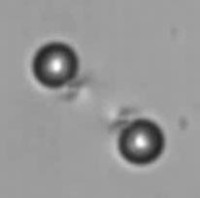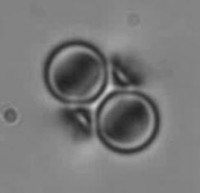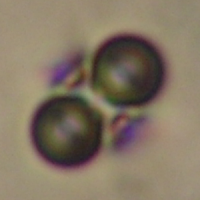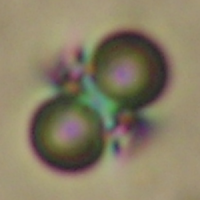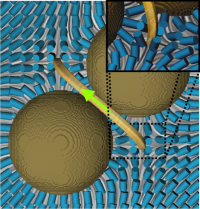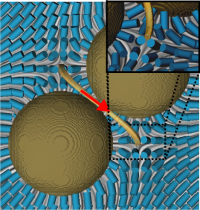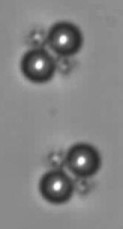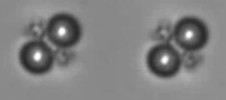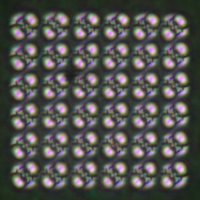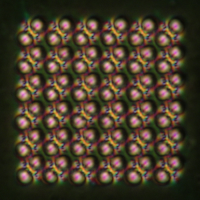Broken mirror symmetry in nematic colloids: chiral dimers and 2D crystals
| When colloidal particles are dispersed in a chiral nematic matrix, such as 90 degrees twisted nematic cell, colloidal self-assembly is substantially different compared to homogeneous nematic. The macroscopic chiral organization of the underlying nematic not only lifts the energy degeneration of recently observed “bubble-gum” colloidal dimers in non-chiral liquid crystal, but also dramatically increases the probability of their formation. We identify experimentally and numerically two basic colloidal dimer conformations in a nematic liquid crystal, that are of opposite chirality and we confirm the non-singular topological nature of their binding. Dimer-dimer interaction weakly depends on the chirality of the dimers and leads to an assembly of 2D nematic colloidal crystals of pure or "mixed" chirality. |
| When the ring defect between the two particles is perturbed by dragging the high-power tweezers focus along the ring, another colloidal dimer could be created, which is quite similar to the original. However, these two colloidal dimers are clearly different. The difference is in the chirality of dimers, which is due to the mechanism of director escape, illustrated in figures below. |
| What is an escaped nematic field? The escape of topological defects has been first reported for a cylindrical capillary, filled with a nematic LC, such that NLC is anchored perpendicular to the inner surface of the capillary. A radial topological defect line is created, which is energetically unstable and transforms into an “escaped nematic field”, shown above. Whereas the radial defect line is singular in the sense, that the nematic order parameter S is very low in the defect core, the escaped field has only minor variations in S and is therefore non-singular in S.
To our surprise, the escaped hyperbolic defect ring mechanism not only results in strongly bound chiral colloidal dimers, but also leads to strong attraction between these dimers, leading to 2D colloidal crystals in as-prepared cells. The unit cell is square, which is not a very common structure as it requires an interaction with a four-fold symmetry axis or a very particular separation dependence of interaction. In our case, a dominant contribution to the effective interaction is coming from the escaped hyperbolic defect ring, which has a pronounced local four-fold symmetry axis. |
| TKALEC, Uroš, RAVNIK, Miha, ŽUMER, Slobodan, MUŠEVIČ, Igor. Vortexlike topological defects in nematic colloids : chiral colloidal dimers and 2D crystals. Phys. rev. lett., 2009, vol. 103, no. 12, 127801-1-127801-4. |


